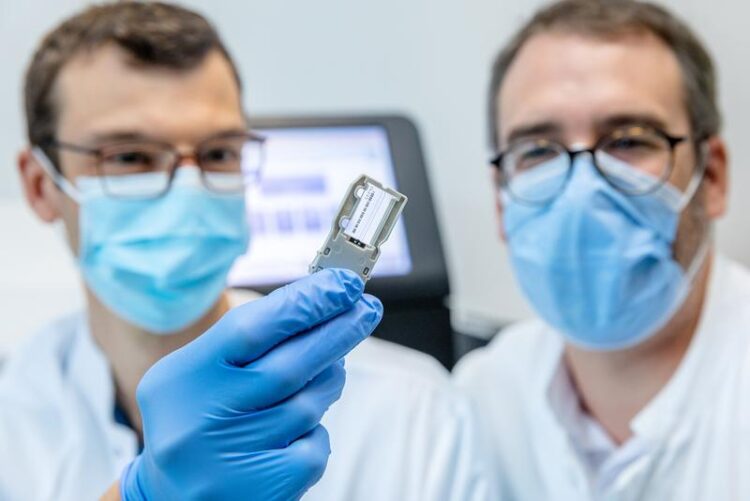Prognosis for effectiveness of leukaemia therapy possible eleven months earlier

Dr. Christian Schultze-Florey (left) and Professor Dr. Christian Könecke with an optical surface for sequencing the cell samples.
Copyright: Karin Kaiser / MHH
MHH research team finds biomarker for treatment success with donor lymphocyte infusion.
When chemotherapy does not help a leukemia patient, stem cell transplantation is the last resort. In this case, the diseased bone marrow is usually replaced by healthy cells from a suitable donor with the help of a transfusion. After the transfusion, the donated stem cells migrate into the bone marrow and begin to form new, healthy blood cells there after some time. However, this is not always successful. Some patients suffer a relapse and then receive additional white blood cells to fight the cancer. These so-called donor lymphocytes can recognise and destroy leukaemia cells. Until now, it was only possible to say how effective this therapy is months later. Now, a research team led by Dr. Christian Schultze-Florey and Professor Dr. Christian Könecke from the Department of Haematology, Haemostaseology, Oncology and Stem Cell Transplantation at Hannover Medical School (MHH), in cooperation with Professor Dr. Immo Prinz from the MHH Institute of Immunology, has developed a method to determine whether an infusion with donor lymphocytes is successful or not eleven months before a possible clinical diagnosis. The research work has been published in the scientific journal Blood Advances.
Cell clones indicate response to infusion
“In our study, we looked at a very specific subset of lymphocytes, namely CD8+ cytotoxic T cells,” says Dr Schultze-Florey. These white blood cells have structures on their cell surface with which they bind directly to the tumour cell and trigger its cell death. If the donor lymphocytes successfully push back the leukaemia, many T-cells of the same type with the CD8+ surface receptors can also be detected. It is crucial that they all belong to the same cell family, i.e. originate from the same cell of origin. “Such cell clones indicate that the cytotoxic T cells are multiplying successfully and that the patient is responding to the therapy,” emphasises Dr. Schultze-Florey. If the therapy is unsuccessful, no growing cell clones can be detected either. “Such CD8+ clones are a biomarker that gives us clues as early as two weeks after treatment as to whether the leukaemia is returning or not,” explains Professor Könecke. These changes were already detected in the study 11 months before the clinical diagnosis of leukaemia relapse.
Biomarker also helps prevent overtreatment
According to the research team, the CD8+ T-cell receptor analysis is a promising tool to predict whether the treatment with donor lymphocytes is successful or whether a relapse is imminent. At the same time, early prognosis can prevent patients from being over treated. Because even if the tissue characteristics on the surface of the donor’s and patient’s blood cells match or are at least very similar, there is still a certain risk that the donated lymphocytes will turn against the patient’s organism. The risk of such a donor-versus-recipient reaction (graft-versus-host disease, GvHD) can now be better weighed. If an increasing number of identical CD8+ clones can be detected, further donor lymphocyte administration may not be necessary. “The results of the study offer a molecular biological approach that shows whether the immunological effect of the donor lymphocytes is successfully initiated in the patients,” the haematologists are pleased to say.
SERVICE:
For further information, please contact Dr Christian Schultze-Florey at schultze-florey.christian@mh-hannover.de, telephone (0511) 532-2324.
The original paper “Clonal expansion of CD8+ T cells reflects graft-versus-leukemia activity and precedes durable remission following DLI” can be found here:
https://ashpublications.org/bloodadvances/article/doi/10.1182/bloodadvances.2020…
Media Contact
All latest news from the category: Health and Medicine
This subject area encompasses research and studies in the field of human medicine.
Among the wide-ranging list of topics covered here are anesthesiology, anatomy, surgery, human genetics, hygiene and environmental medicine, internal medicine, neurology, pharmacology, physiology, urology and dental medicine.
Newest articles

Parallel Paths: Understanding Malaria Resistance in Chimpanzees and Humans
The closest relatives of humans adapt genetically to habitats and infections Survival of the Fittest: Genetic Adaptations Uncovered in Chimpanzees Görlitz, 10.01.2025. Chimpanzees have genetic adaptations that help them survive…

You are What You Eat—Stanford Study Links Fiber to Anti-Cancer Gene Modulation
The Fiber Gap: A Growing Concern in American Diets Fiber is well known to be an important part of a healthy diet, yet less than 10% of Americans eat the minimum recommended…

Trust Your Gut—RNA-Protein Discovery for Better Immunity
HIRI researchers uncover control mechanisms of polysaccharide utilization in Bacteroides thetaiotaomicron. Researchers at the Helmholtz Institute for RNA-based Infection Research (HIRI) and the Julius-Maximilians-Universität (JMU) in Würzburg have identified a…



